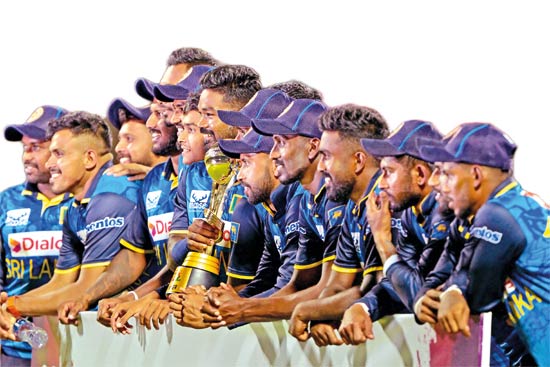Bangla blunder: a wakeup call more than a testing ground
That would be the enlightened and progressive outlook one is expected to adopt in the wake of yet another baffling performance from our national cricket team.
Dig a little beneath the usual ‘these things happen’ homily and you’ll stumble upon the one true hallmark of contemporary Sri Lankan cricket: glorious, almost poetic, inconsistency. It’s practically an art form now. Since we bid farewell to the golden generation nearly a decade ago, our most reliable feature has been our unreliability. If one week we are dismantling world champions with panache, the next we trip over our own shoelaces against a side that has only just learned how to tie theirs.

They win some, but when they lose, it's more than haunting
Take fielding. On some days, we produce moments of brilliance that defy belief—athleticism and awareness combining in ways that would impress even the world’s best. One such example was Janith Liyanage’s flying catch to dismiss Tanzid Hasan for 62 runs during the first ODI. On others, we descend into carelessness, dropping straightforward chances with alarming calmness. Maheesh Theekshana’s missed dolly at extra cover on Wednesday was a clear instance of this.
This Bangladesh tour, in theory, was meant to be a routine confidence-boosting pit stop for the hosts. A gentle canter through three formats. Instead, the Test series ended 1-0, with a high-scoring draw in the opening game highlighting another inconvenient truth: our supposedly fearsome spin attack struggles to extract anything out of a flat Galle pitch when the conditions aren’t bending over backward to help.
 Prabath Jayasuriya, once hailed as the next big thing in spin bowling, now seems entirely dependent on friendly surfaces. Comparisons to Murali and Herath, once enthusiastic, now feel increasingly absurd. Then again, Sri Lanka’s spin cupboard isn’t just bare; it’s cobwebby. What have our handsomely paid coaching staff done to address this?
Prabath Jayasuriya, once hailed as the next big thing in spin bowling, now seems entirely dependent on friendly surfaces. Comparisons to Murali and Herath, once enthusiastic, now feel increasingly absurd. Then again, Sri Lanka’s spin cupboard isn’t just bare; it’s cobwebby. What have our handsomely paid coaching staff done to address this?
Even in ODIs, where we have performed reasonably well, recording series wins over India, West Indies, New Zealand and Australia at home under Charith Asalanka’s captaincy, the underlying issues remain evident. Despite convincing wins in the first and third matches against Bangladesh, the collapse in the second game was stark and troubling. It highlights a deeper problem—our inability to maintain consistency, even against weaker opposition.
And then came the T20s. The opener in Pallekele was vintage Sri Lanka—explosive, confident, convincing. Pathum Nissanka and Kusal Mendis were brutal. Naturally, hopes soared. Then Dambulla happened: an 83-run hammering that went down as our worst-ever T20 defeat at home. And just in case fans hadn’t yet hit their quota of disappointment, Colombo offered a final chapter of confusion and chaos. Asalanka commendably owned up to misreading the pitch. What he omitted was everything else they misread—game awareness, shot selection, team balance, bowling plans, the very concept of pressure. A buffet spread of blunders.
At the core of it all lies an unsettling reality. Sri Lankan cricket is continously in the midst of a profound crisis. From 2007 to 2014, we were regular finalists and consistent contenders on the global stage. Today, avoiding a collapse is seen as a small victory—a stark indicator of how far we’ve fallen.
Avishka Fernando’s T20 selection was eyebrow-raising but not entirely out of character for our selection panel, who’ve perfected the ‘pick and pray’ method. Then there’s Chamika Karunaratne and Dasun Shanaka—two all-rounders of identical effect. Shanaka, once dropped with dramatic flair, is back, managing a brisk 22 in the final over of the third T20, showing he still can hit the long ball. It didn’t change the outcome, but hey, it made the scorecard look slightly more respectable.
Kusal Janith Perera, once a dynamic force in Sri Lankan cricket, now appears to be a player well past his prime, brought back more out of hope than form. Dinesh Chandimal was given an opportunity after three years when Avishka failed to grab the slot, but his performance did little to justify the decision, offering neither impact nor presence.
With the T20 World Cup just months away, we don’t have a settled XI, a clear tactical vision, or any sense of direction. While the rest of the world embraces data-driven selections and tailored strategies, Sri Lanka clings to name recognition and sentimental comebacks.
Sanath Jayasuriya’s legacy as a batting icon is unquestionable. However, excellence on the field does not automatically translate into success in the coaching arena. Coaching demands more than instinct and past glories—it requires strategic vision, the ability to manage diverse personalities, and the discipline to build a cohesive high-performance environment. So far, Jayasuriya’s tenure as Consultant Head Coach has offered little evidence of a clear direction or structured approach. The question remains: can the trailblazing opener who once redefined the game now guide a struggling team back from the edge of irrelevance?
Time, unfortunately, is not on our side. The World Cup is looming, and unless something changes—and fast—we risk showing up with little more than blind optimism.
To fully understand the depth of Sri Lanka’s decline, one must look beyond the scorecards. Between 2007 and 2014, Sri Lanka consistently reached the summit of world cricket, featuring in every major final. But what followed has been a stark and troubling reversal—an unrelenting series of early exits and a rapid slide from global contender to a fading memory of former greatness.
Adaptability is a trait that separates merely good teams from truly great ones and, regrettably, it’s the very quality that seems glaringly absent in the current setup. In the modern game, where conditions shift rapidly and opponents evolve in real time, the ability to read situations and respond accordingly is non-negotiable. Yet what we continue to witness is a team locked in a rigid, pre-planned approach, seemingly unable or unwilling to adjust as the match unfolds.
What’s more disheartening is the growing disconnect between words and action. Post-match interviews are often drenched in hollow optimism. Phrases like “we take the positives” or “we’re heading in the right direction” are thrown around with robotic regularity. But there’s little evidence of meaningful evolution. Until adaptability becomes more than just a buzzword, the team will remain a few gears short of greatness, trapped in a cycle of familiar failures.
Talent is not our problem. It is the management of talent. We continue to shuffle players without a coherent plan, prioritising reputation over form and rewarding flashy style over substance. This isn’t just poor strategy—it’s incompetence.
Sri Lanka’s road back won’t be paved with nostalgia or blind faith. It will demand ruthless decisions, consistent accountability, and a willingness to break from the comforting chaos that has defined us for too long. The rest of the cricketing world is moving forward and fast. If we don’t catch up, we risk becoming that sad old story told in the past tense.


